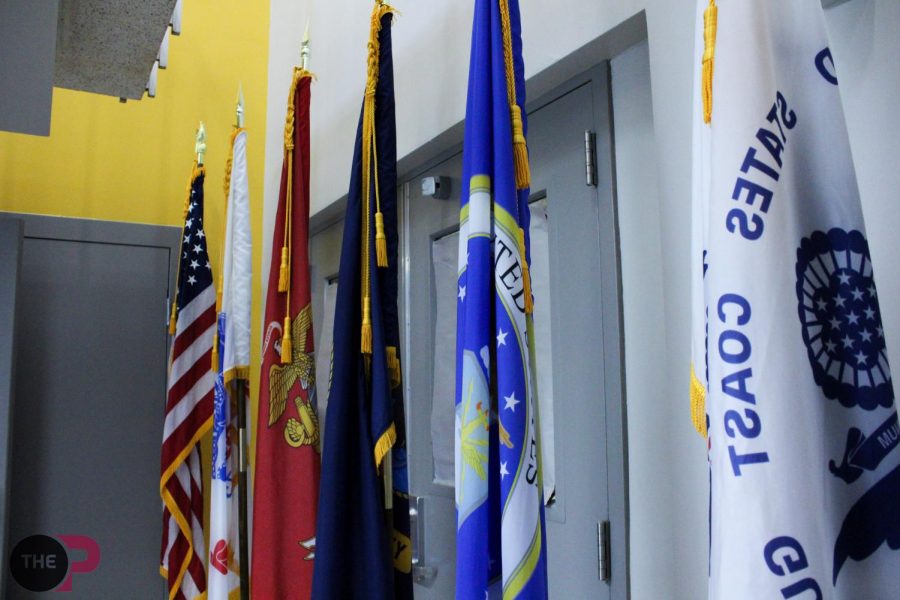Vet center moves to larger space in Vandenberg Hall
It has been seven years since an old breakroom in North Foundation Hall was converted into the first Veteran Support Services (VSS) Center on Oakland University’s campus according to Eric Wuestenberg, coordinator for VSS.
Wuestenberg was hired on as the first full-time staff member on June 5, 2017, at which point he found there was not even a computer and phone on each desk.
As of this fall, the VSS Center has now been upgraded to Room 112 of East Vandenberg, making the leap from 230 square feet to 2,220.
“It makes people feel more comfortable to come in because they don’t feel that claustrophobic,” said Tyler Digiacomo, president of Student Veterans of Oakland University (SVOU). “A lot of vets face that whole anxiety type thing of being in crowded areas, so now that we have a bigger space, we’re getting more of a presence and people are coming to hang out and do homework and just relax.”
While Wuestenberg is hopeful all 355 veteran students using benefits at OU will utilize the center, there has already been about 50 unique visitors a day.
“We’re seeing a lot more faces and a lot more regularity of folks now that they know, but we’ve only been in this space a couple of weeks,” Wuestenberg said. “A lot of folks didn’t even know we had space, so really spreading the word is going to be huge for us.”
New and continuing programs through the VSS Center include a textbook loan program, which is always accepting donations, a computer and print lab area, VA Certification, an open lounge area and more.
Those using VA benefits are welcome to eat lunch, do homework, hang out, socialize and work on group projects in the center.
“It’s really like a one-stop shop so it’s benefiting the students more than anything,” Digiacomo said. “Really we’re just trying to make it easier and more enjoyable pretty much just to come to school.”
Looking toward the future of further improving veteran services in campus, a vocational rehabilitation counselor for disabled veterans on campus will be making the move from her current office in Detroit to OU’s VSS Center as soon as the space becomes available.
This will bring veteran students from Oakland Community College, Macomb Community College and Baker College, totaling at around 2,500 students, to Oakland’s campus, according to Wuestenberg.
More long-term goals include bringing PAVE, a transition assistance program and more ROTC crosstown agreements to student veterans at OU.
The center is currently open 8 a.m. to 5 p.m. on weekdays, but may soon switch to 7 a.m. to 7 p.m.
“We’re all just so tickled to have this space, there’s not a frown around at all,” Wuestenberg said. “I say it almost every morning when I come in and unlock the door, ‘pinch me, is this real?’”
Road March for Hunger nearly doubles donations
The annual Road March for Hunger, put on by Students Veterans of Oakland University, took place on Sept. 11 this year. The OU community was asked to bring donations of food and other items for local veterans who are homeless, and then invited to carry the items on a one-mile walk, symbolizing the weight veterans bear.
All branches of the military, with the exception of The Coast Guard, participated this year. With this and the combination of better weather than previous years along with a more centralized location under the clock tower, the event nearly doubled its donations.
Over 1,000 lbs. of food was collected as well as an estimated $1,400 according to Wuestenberg.
POW Table offers reflective addition to the center
Among the variety of new areas built into the center now sits a carefully constructed table. Placed in a corner near the entry, the POW (Prisoner of War) Table honors the memory of fallen, missing or imprisoned military service members.
Here are what the items stand for according to the Pennsylvania VFW:
- The small table is set for one – symbolizing the frailty of one prisoner.
- The table is round – showing our everlasting concern for our POW/MIA’s.
- The cloth is white – symbolizing the purity of our men and women’s motives when answering the call to duty.
- The single red rose – reminding us of the lives of these men and women – their loved ones and friends who keep the faith, while seeking answers.
- The red ribbon – symbolizes our continued determination to account for them.
- A slice of lemon – reminds us of the bitter fate of those missing, captured and held as prisoners in foreign lands.
- A pinch of salt – symbolizes the tears of our missing and their families who long for answers after decades of uncertainty.
- The Holy Bible – represents the strength gained through faith in our country, founded as one nation under God, to sustain those lost from our midst.
- The candle – is reminiscent of the light of hope which lives in our hearts to illuminate their way home.
- The glass is inverted – to symbolize their inability to share this evening’s toast.
- The chair is empty – they are missing – (silent moment) – and please remember their service and sacrifice.









